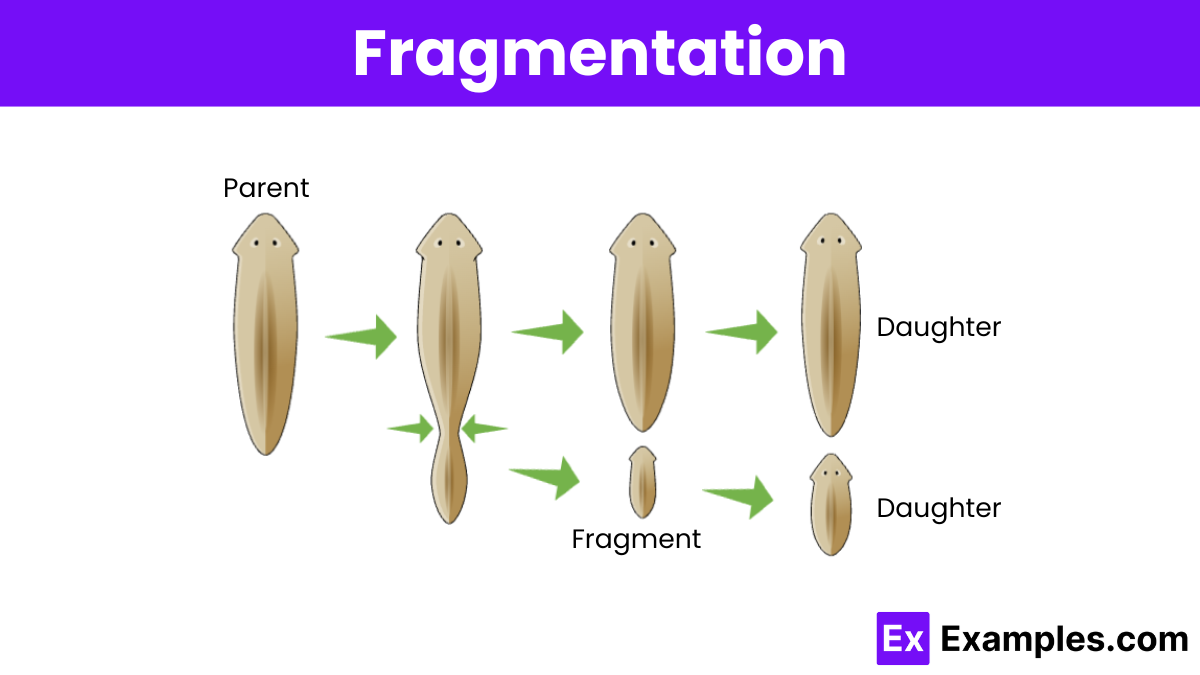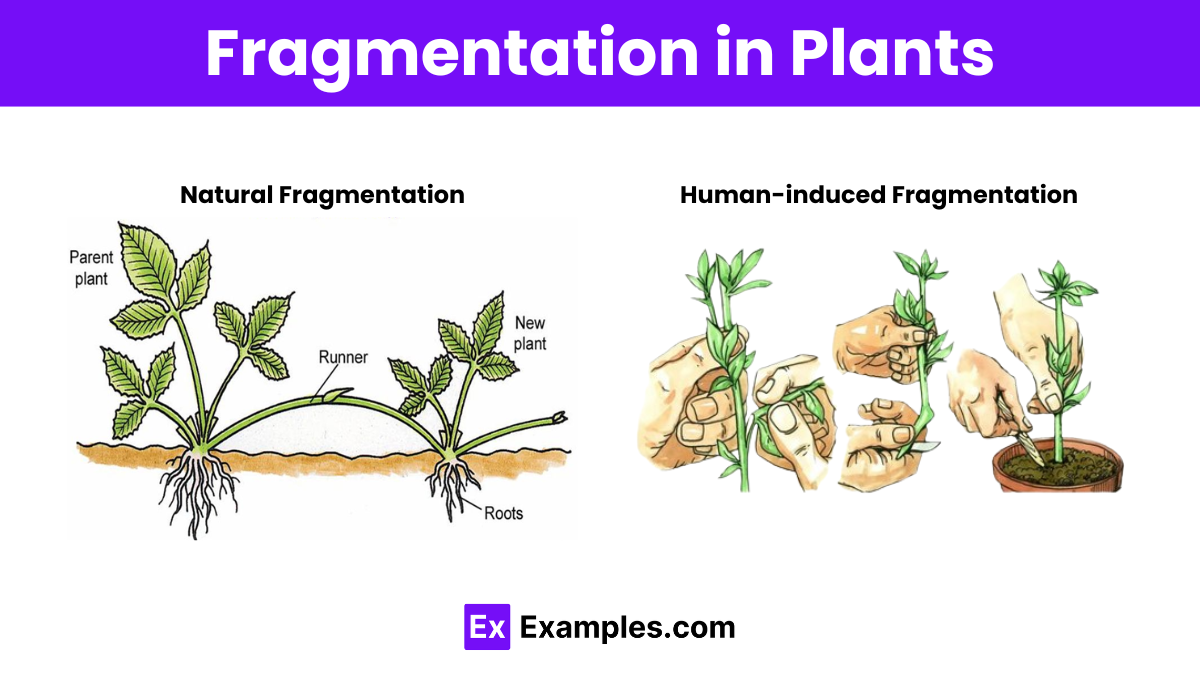Which of the following is an example of an organism that exhibits incomplete fragmentation?
Starfish
Planaria
Hydra
Earthworm


Fragmentation plays a crucial role in the reproductive strategies of many organisms across different kingdoms of life. This biological process allows an organism to reproduce asexually by breaking into two or more fragments, each capable of growing independently into a new organism. Widely observed in both multicellular and unicellular organisms, fragmentation is a fascinating adaptation that enhances survival and dispersal in diverse environments. From fungi and lichens to plants and simple animals, fragmentation showcases the incredible versatility and resilience of life. In this article, we delve into the mechanisms, advantages, and ecological significance of fragmentation, highlighting its pivotal role in the natural world.
Fragmentation refers to a form of asexual reproduction wherein an organism splits into fragments, and each fragment develops into a mature, fully-grown individual. This process is distinct from other reproductive strategies because it does not involve the production of spores or seeds. Fragmentation typically occurs when an organism’s body part is broken off due to environmental factors or through deliberate actions by the organism itself. This method is especially common among organisms that lack a complex reproductive system.
Reproduction is the biological process through which organisms produce new individuals. This can occur via sexual or asexual means. In sexual reproduction, two parents each contribute genetic material through the fusion of gametes—the egg from a female and sperm from a male. Fertilization occurs, leading to the formation of a zygote which subsequently develops into an embryo and matures into a new organism. Sexual reproduction includes various methods such as allogamy, internal and external fertilization, and autogamy.
In contrast, asexual reproduction involves a single parent and does not involve the fusion of gametes. Common types include binary fission, budding, fragmentation, and parthenogenesis. Binary fission is typical in bacteria where one cell divides into two. Budding occurs in organisms like yeasts and hydras, where new individuals form as buds on the parent body and eventually separate to grow independently.
Taking Planaria as an example—these flatworms, belonging to the class Rhabditophora and phylum Platyhelminthes, demonstrate the process of fragmentation effectively. When a part of a Planaria’s body becomes separated, it has the innate ability to regenerate and grow into a full organism. Each fragment develops into a mature planarian, identical to the original. The body of a planarian can split into multiple pieces, and each piece is capable of regenerating missing parts to form a new, complete individual. This remarkable regeneration process ensures that each new planarian will exhibit the same genetic makeup as its parent, thereby maintaining the species’ characteristics through generations.
Commonly observed in colonial organisms such as corals and bryozoans, zooid fragmentation occurs when a colony’s individual members, known as zooids, detach and develop into new colonies. This type of fragmentation is vital for the propagation and spatial distribution of these marine organisms.
In fission, an organism divides into two or more parts that regenerate into separate, fully-formed organisms. This is typical in organisms like bacteria, amoebae, and planarians. Fission can be symmetrical, where the organism splits into two equal halves, or asymmetrical, leading to varied sizes of the resulting organisms.
Architomy is a type of fragmentation seen in some annelids and flatworms, where an organism splits into segments without prior preparation of the organs for the new fragments. Each fragment then regenerates the missing parts to become a complete organism.
An advanced form of fragmentation, paratomy involves the partial development of new individuals while still attached to the parent organism. This is seen in certain annelids, where new segments develop organs before they detach, ensuring a higher survival rate of the fragments.
Plants often utilize vegetative fragmentation, where parts of the plant such as leaves, stems, or roots detach and grow into new plants. This is common in species like starfish and many types of grasses, which can propagate efficiently through natural or induced fragmentation.
Although typically associated with the production of spores, sporulation in certain fungi and bacteria can also involve the breaking off of spore-containing fragments that grow into new organisms. This method combines elements of both asexual reproduction and fragmentation.
Many plants, especially non-vascular ones like liverworts and mosses, reproduce via fragmentation. Certain grasses and perennials also utilize this method when their stems or roots break off and develop into new plants. This ability enhances their resilience and spread, especially in harsh environmental conditions.
Fungi can reproduce through fragmentation when mycelial fragments (parts of the fungus consisting of a mass of branching, thread-like hyphae) separate and grow into new colonies. This is a rapid method of reproduction that helps fungi colonize new areas quickly.
Fragmentation is also found in various animal species, particularly invertebrates such as sponges, sea stars, and planarians. For example, if a sea star’s limb is severed, it can regenerate into a complete sea star, provided it contains part of the central disk. This remarkable regenerative capability allows these organisms to survive and propagate even after substantial injury.
Certain microorganisms, including bacteria and cyanobacteria, can undergo fragmentation. In these organisms, cells or colonies divide into two or more parts, each capable of growing into a new individual. This process is a crucial survival and propagation strategy in microscopic life forms.
Starfish Plant (Succulent)
Spider Plant
Mushrooms
Planarians (Flatworms)
Sea Stars (Starfish)
Corals
Yeast

Fragmentation typically occurs in two main ways:
Fragmentation is asexual reproduction where organisms split into fragments, each growing into a new organism.
Examples include starfish, corals, sponges, and certain algae and fungi.
Fragmentation is a form of asexual reproduction. Other common types include binary fission, budding, and parthenogenesis.
Fragmentation occurs in both prokaryotic and eukaryotic organisms, facilitating asexual reproduction.
In fragmentation, an organism breaks into parts that regenerate into new, complete organisms.
Text prompt
Add Tone
10 Examples of Public speaking
20 Examples of Gas lighting
Which of the following is an example of an organism that exhibits incomplete fragmentation?
Starfish
Planaria
Hydra
Earthworm
Incomplete fragmentation results in:
Complete new organisms
Partial regeneration
No regeneration
Multiplication of organisms
Which of the following is NOT a result of incomplete fragmentation?
Formation of new organisms
Limited regrowth
Partial repair of body parts
Complete restoration of lost parts
Incomplete fragmentation is commonly observed in:
Vertebrates
Invertebrates
Mammals
Birds
What is a key difference between complete and incomplete fragmentation?
Number of offspring produced
Speed of regeneration
Extent of regrowth
Type of organisms
Which of the following best describes incomplete fragmentation in starfish?
Regeneration of a full starfish from a single arm
Regrowth of missing parts but not forming a new individual
No regeneration at all
Production of multiple new starfish
Incomplete fragmentation in plants can result in:
New plants
Partial regrowth of damaged areas
No growth
Seeds
Which factor does NOT influence incomplete fragmentation?
Environmental conditions
Genetic factors
Presence of nutrients
Seasonal changes
Incomplete fragmentation can be considered a form of:
Asexual reproduction
Sexual reproduction
Sporulation
Binary fission
What role do stem cells play in incomplete fragmentation?
They prevent regrowth
They initiate regrowth
They form gametes
They decompose the damaged parts
Before you leave, take our quick quiz to enhance your learning!

